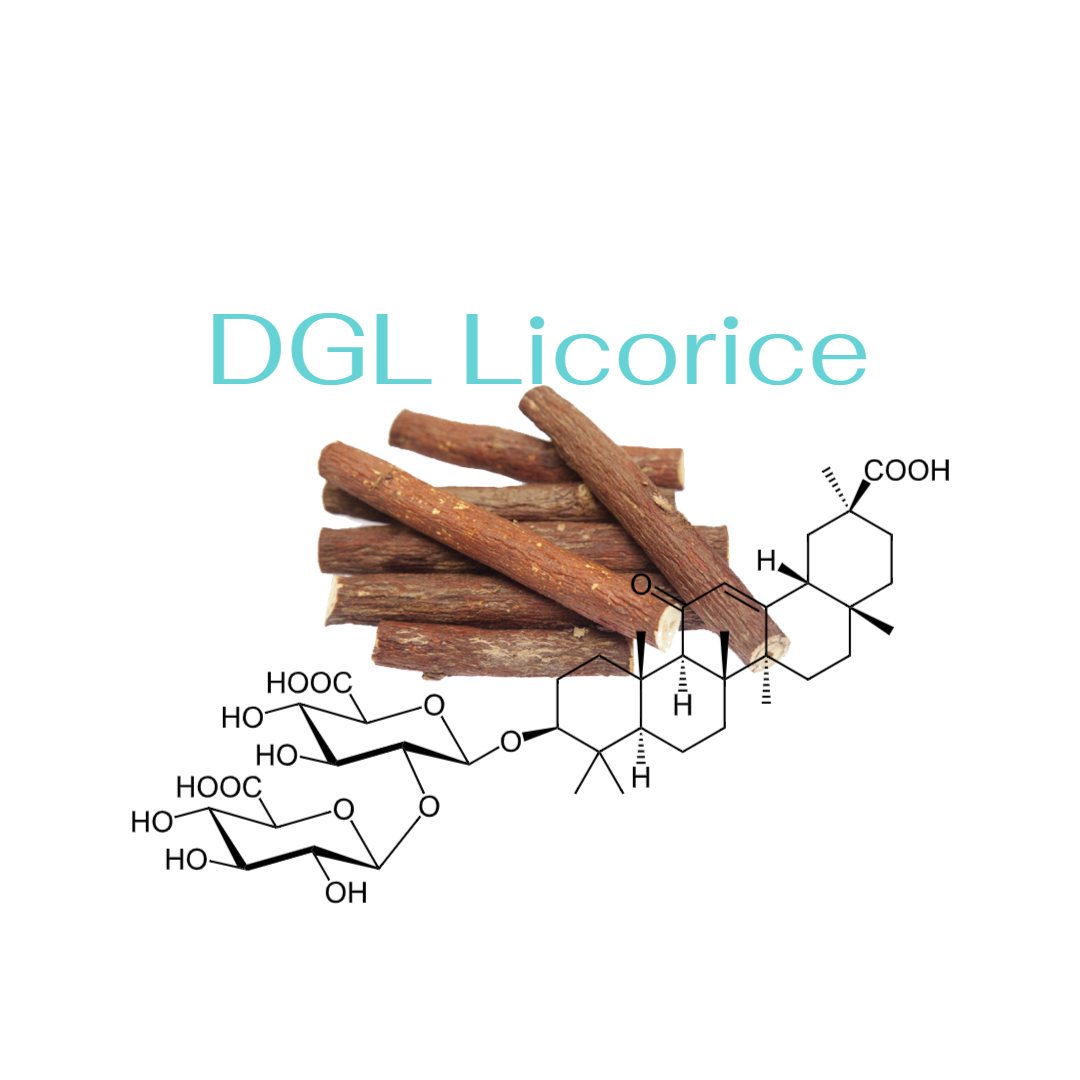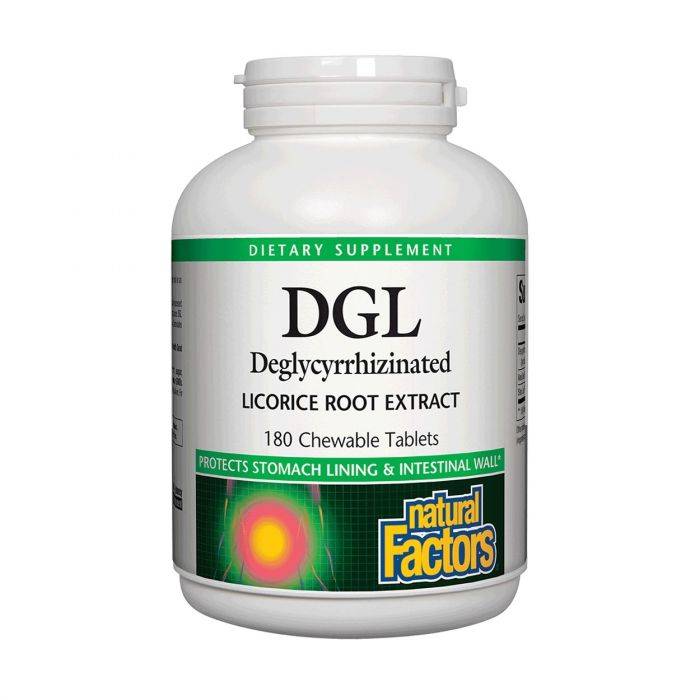DGL Licorice

There is no person who has not suffered from stomach upset at least once in their life.
There can be various symptoms of this through acid overload to stomach pain and acid regurgitation.
These can cause, of course, various acute and chronic diseases, all of which are: gastritis, gastric ulcer, and so on.
DGL licorice
For repairing gut lining and reducing heartburn
Gastric complaints are often caused by an imbalance between the acidity of the stomach and its ability to protect the stomach from the irritating effects of the acids. The presence of some harmful bacteria can also cause stomach upsets. The stomach, which is produced by millions of cells on the stomach wall and is called a mucin, is responsible for protecting the stomach.
Synthetic drugs usually neutralize acid, but the body needs it to digest food. The relief of pain caused by acid overload or stomach ulcers is achieved by taking medications that involve the stomach and gut mucosa, which also prevents digestion. These drugs eliminate the symptoms in the short term, but have harmful effects in the long run.
What is DGL – Licorice Root Extract?
DGL is a de-glycyrrhizinic licorice root, which means that the harmful glycyrrhizin has been removed from it. DGL thus provides a natural, unique and effective solution to stomach problems.
A study in 16 patients with severe stomach problems showed that taking 360 mg DGL 3 times a day (with 3 main meals) reduced symptoms by an average of 78%.
However, another study showed that DGL – Licorice Root Extract 760 mg, also 3 times a day, had the same effect as the medicines used for the same purpose (cimetidine), but without the side effects.
Licorice root, which is considered one of the world’s oldest herbal remedies, comes from the root of the licorice plant. Licorice grows in parts of Europe and Asia. The chemicals in licorice are thought to decrease swelling, decrease cough, and increase the chemicals in our body that heal ulcers.
Properties and effects of DGL licorice:
- The flavonoids in the composition help stop excessive acid production
- It increases blood circulation at the level of stomach-producing cells in the stomach wall
- It increases the production of gastric mucus, which protects the stomach wall
- It promotes the growth of new mucosal cells
- DGL is de-glycyrrhizinated to avoid side effects
How does licorice work?
The success of this is not only due to the fact that it does not completely inhibit the production of acid in the stomach, but stimulates mucin production and the formation of mucin-producing cells by stimulating blood circulation at the level of the stomach wall.
The only problem to long-term use is glycyrrhizin, which can increase blood pressure and water retention. However, if this ingredient is removed, this undesirable side effect will also disappear.
Resources
[1]
Wijendran V, Huang MC, Diau GY, et al. Efficacy of dietary arachidonic acid provided as triglyceride or phospholipid as substrates for brain arachidonic acid accretion in baboon neonates. Pediatr Res 2002;51:265-272.
[2]
Goustard-Langelier B, Guesnet P, Durand G,et al. n-3 and n-6 fatty acid enrichment by dietary $sh oil and phospholipid sources in brain cortical areas and nonneural tissues of formula-fed piglets. Lipids 1999;34:5-16.
[3]
Maki KC, Reeves MS, Farmer M, et al. Krill oil supplementation increases plasma concentrations of eicosapentaenoic and docosahexaenoic acids in overweight and obese men and women. Nutr Res 2009;29:609-615.
[4]
Bunea R, El Farrah K, Deutsch L. Evaluation of the effects of Neptune Krill Oil on the clinical course of hyperlipidemia. Altern Med Rev 2004:9:420-428.
[5]
Sampalis F, Bunea R, Pelland MF, et al. Evaluation of the effects of Neptune Krill Oil on the management of premenstrual syndrome and dysmenorrhea. Altern Med Rev 2003;8:171-179.
[6]
Deutsch L. Evaluation of the effect of Neptune Krill Oil on chronic inflammation and arthritic symptoms. J Am Coll Nutr 2007:26:39-48.
[7]
Chang JP, Chen YT, Su KP. Omega-3 polyunsaturated fatty acids (n-3 PUFAs) in cardiovascular diseases (CVDs) and depression: Cardiovasc Psychiatry Neurol 2009;2009:725310. Epub 2009 Sep 27.
[8]
Breslow J. n-3 fatty acids and cardiovascular disease. Am J Clin Nutr 2006;83:1477S-1482S.
[9]
Calzolari I, Fumagalli S, Marchionni N, DiBari M. Polyunsaturated fatty acids and cardiovascular disease. Curr Pharm Des 2009;15:4094-4102.
[10]
No authors listed. Phosphatidylcholine. Altern Med Rev 2002;7:150-154.
[11]
Naguib YM. Antioxidant activities of astaxanthin and related carotenoids. J Agric Food Chem 2000;48:1150-1154.
[12]
Tso P, Drake DS, Black DD, Sabesin SM. Evidence for separate pathways of chylomicron and very low-density lipoprotein assembly and transport by rat small intestine. Am J Physiol 1984;247:G599-G610.
[13]
Amate L, Gil A, Ramirez M. Feeding infant piglets formula with long-chain polyunsaturated fatty acids as triacylglycerols or phospholipids influences the distribution of these fatty acids in plasma lipoprotein fractions. J Nutr 2001;131:1250-1255.
[14]
Tandy S, Chung RW, Wat E, et al. Dietary krill oil supplementation reduces hepatic osteatosis, glycemia, and hypercholesterolemia in high-fat-fed mice. J Agric Food Chem 2009;57:9339-9345.
[15]
Alberts B, Johnson A, Lewis J, et al. Molecular Biology of the Cell. 4th ed. New York, NY: Garland Science; 2002
[16]
Else PL, Hulbert AJ. Membranes as metabolic pacemakers. Clin Exp Pharmacol Physiol 2003;30:559-564
[17]
Kidd PM. Omega-3 DHA and EPA for cognition, behavior, and mood: clinical findings and structural-functional synergies with cell membrane phospholipids. Altern Med Rev. 2007 Sep;12(3):207-27.
[18]
Konagai C, Yanagimoto K, Hayamizu K, Han L, Tsuji T, Koga Y. Effects of krill oil containing n-3 polyunsaturated fatty acids in phospholipid form on human brain function: a randomized controlled trial in healthy elderly volunteers. Clin Interv Aging. 2013;8:1247-57.
[19]
Ebrahimi M, Ghayour-Mobarhan M, Rezaiean S, et al. Omega-3 fatty acid supplements improve the cardiovascular risk profile of subjects with metabolic syndrome, including markers of inflammation and auto-immunity. Acta Cardiol. 2009 Jun;64(3):321-7.
[20]
Derosa G, Cicero AF, Fogari E, et al. Effects of n-3 PUFAs on postprandial variation of metalloproteinases, and inflammatory and insulin resistance parameters in dyslipidemic patients: evaluation with euglycemic clamp and oral fat load. J Clin Lipidol. 2012 Nov-Dec;6(6):553-64.
[21]
Spencer M, Finlin BS, Unal R, et al. Omega-3 fatty acids reduce adipose tissue macrophages in human subjects with insulin resistance. Diabetes. 2013 May;62(5):1709-17.
[22]
Yan Y, Jiang W, Spinetti T, et al. Omega-3 fatty acids prevent inflammation and metabolic disorder through inhibition of NLRP3 inflammasome activation. Immunity. 2013 Jun 27;38(6):1154-63.
[23]
Valensa. FlexPro MD Clinical Trial Overview and Results. (Data on File.) 2011
[24]
McCann JC, Ames BN. Is docosahexaenoic acid, an n-3 long-chain polyunsaturated fatty acid, required for development of normal brain function? An overview of evidence from cognitive and behavioral tests in humans and animals. Am J Clin Nutr 2005;82:281-295.
[25]
Stevens LJ, Zentall SS, Abate ML, et al. Omega-3 fatty acids in boys with behavior, learning, and health problems. Physiol Behav 1996;59:915-920.


